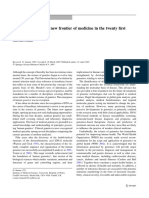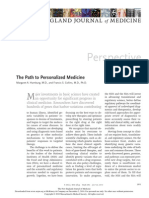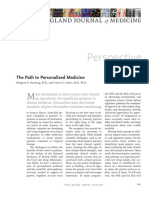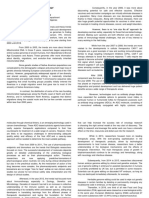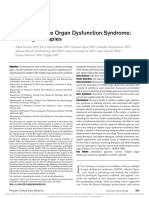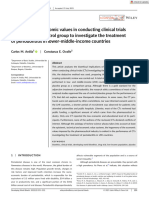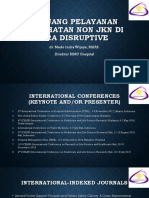Jed120070 923 924
Jed120070 923 924
Uploaded by
LyinglionCopyright:
Available Formats
Jed120070 923 924
Jed120070 923 924
Uploaded by
LyinglionOriginal Title
Copyright
Available Formats
Share this document
Did you find this document useful?
Is this content inappropriate?
Copyright:
Available Formats
Jed120070 923 924
Jed120070 923 924
Uploaded by
LyinglionCopyright:
Available Formats
EDITORIAL Editorials represent the opinions
of the authors and JAMA and
not those of the American Medical Association.
Genomics in Health Care
Call for Papers for the 2013 Theme Issue
W. Gregory Feero, MD, PhD genome sequence information for both clinical research
and care. Without novel methods for providing near real-
Phil B. Fontanarosa, MD, MBA time, low-cost interpretation of the genome, use of high-
throughput technologies like next-generation sequencing
S
INCE THE 2001 PUBLICATION OF THE DRAFT HUMAN GE- will be limited to a subset of highly resourced academic
nome sequence,1 genomic technologies have revo- medical centers.
lutionized the conduct of biomedical research. Cur- Third, robust and cost-effective strategies need to be de-
rent studies, many of which would have been veloped for generating evidence of benefit for emerging ge-
unimaginable as few as 5 years ago, are reshaping under- nomic technologies. Genomics is coming of age during a
standing of the foundations of health and disease in pro- time of global fiscal budget austerity, and traditional clini-
found and often unexpected ways. Most important to the cal trials are extremely expensive. Models for funding clini-
practicing clinician, advances in genomic technologies are cal trials that have worked for blockbuster drugs are not likely
yielding tangible benefits to increasing numbers of pa- to work for molecular diagnostics and other genomic tech-
tients. Although some have bemoaned the relatively slow nologies with small target populations or low profit mar-
pace of translation of genomic discovery to improved health gins. Lack of an evidence base, measured in terms of im-
outcomes, it is important to recognize that the intersection proved morbidity and mortality, will hinder clinical guideline
of genomic science and health care is in its infancy.2 development and the willingness of payers to reimburse for
Despite this, today, virtually every medical specialty is af- genomic technologies.
fected by genomic advances, although the influence of these Fourth, relatively little is known about how to deliver ge-
advances in day-to-day care varies. For example, in a re- nomic services to ensure equitable, effective, and efficient
port recently published by a major health insurer, molecu- care. Ample evidence suggests that there are significant
lar diagnostics were estimated to account for 8% of expen- knowledge deficits among clinicians and the public regard-
ditures on laboratory diagnostic testing in the United States ing genomics, and there is a shortage of health care profes-
in 2010, with projected double-digit yearly growth rates sionals adequately trained to deliver genomic services.4 This
through 2020.3 In the setting of limited health care re- suggests that proven genomic technologies must be inte-
sources, the rapidly expanding expenditure on molecular grated into health care workflows in ways that are not de-
diagnostics affects even those clinicians who have never or- pendent on clinician expertise. In all probability this will
dered a genetic test. The advent of very low-cost ap- necessitate development of electronic clinical decision sup-
proaches for genome sequencing promises to further accel- port tools that are capable of providing point-of-care re-
erate the discovery process, and for individuals affected by sources for consumers and health care professionals.
currently untreatable conditions the advances cannot come Fifth, genomic technologies are challenging the bound-
too quickly. aries of what is possible vs what is desirable in the context
Considerable challenge and opportunity exist at the in- of human health and health care. Direct-to-consumer ge-
tersection of genomics and health care. Five topic areas span- netic testing, the blurring of lines between clinical care and
ning the continuum of translational research stand out. First, research, and assisted reproductive technologies are but a
human genome structure and function are dauntingly com- few of the arenas in which questions about genomics and
plex. Much remains to be learned about gene structure, func- society have rapidly transitioned from theoretical to con-
tion, and regulation and how these processes relate to nor- crete. Proven frameworks for education, communication,
mal and disease phenotypes in the context of differing and decision making are needed to guide health care con-
environments. New experimental and computational ap- sumers, clinicians, health care organizations, and policy mak-
proaches are needed to sort out this complexity. ers in the current time of often highly polarized health care
Second, assigning causality (or at least a probability of discourse.
causality) to newly detected variations in an individual’s
Author Affiliations: Dr Feero (w.gregory.feero@mainegeneral.org) is Contribut-
genome is currently an extremely arduous and costly ing Editor and Dr Fontanarosa is Executive Deputy Editor, JAMA. Dr Feero is also
task. This limits the ability to harness the potential of with the Maine Dartmouth Family Medicine Residency, Fairfield.
©2012 American Medical Association. All rights reserved. JAMA, September 5, 2012—Vol 308, No. 9 923
Downloaded From: https://jamanetwork.com/ on 02/09/2023
EDITORIAL
To focus attention on and inform readers about these ity that are not of sufficiently broad interest for JAMA
important issues, in April 2013, JAMA will publish a may automatically be considered for publication in
theme issue and The JAMA Network Journals5 will pub- appropriate subspecialty journals in The JAMA Network.
lish theme issues or articles devoted to genomics in Manuscripts received before November 1, 2012, will have
health care. We are pleased to announce a call for sub- the best chance for consideration for inclusion in the
missions of original scholarly works related to this topic. 2013 theme issue on Genomics in Health Care. The edi-
For the purpose of the issue, genomics will be liberally tors look forward to receiving your manuscripts for this
interpreted to encompass investigations involving a holis- important issue of JAMA.
tic approach to understanding how genes and gene prod- Conflict of Interest Disclosures: The authors have completed and submitted the
ucts interact with each other and the environment to ICMJE Form for Disclosure of Potential Conflicts of Interest and none were re-
ported.
result in health or disease. Manuscripts addressing 3
major thematic areas related to genomics will be consid-
REFERENCES
ered for publication: (1) advances in the understanding
of health and disease states; (2) advances in prevention, 1. Lander ES. Initial impact of the sequencing of the human genome. Nature. 2011;
470(7333):187-197.
diagnosis, and treatment of health conditions; and (3) 2. Green ED, Guyer MS; National Human Genome Research Institute. Charting a
advances in the translation of genomics to improved course for genomic medicine from base pairs to bedside. Nature. 2011;470
(7333):204-213.
health outcomes in individuals and populations, includ- 3. Personalized Medicine: Trends and Prospects for the New Science of Genetic
ing issues related to a broader context of genomics in Testing and Personalized Medicine. United Health Center for Health Reform and
society. In addition to original research reports, we also Modernization; March 2012. http://www.unitedhealthgroup.com/hrm
/UNH_WorkingPaper7.pdf.
invite submission of authoritative review articles and 4. Genetics Education and Training: Report of the Secretary’s Advisory Com-
scholarly Viewpoints that inform the topic of genomics in mittee on Genetics, Health, and Society. http://oba.od.nih.gov/oba/SACGHS
/reports/SACGHS_education_report_2011.pdf. February 2011. Accessed July 30,
health care. 2012.
Authors are encouraged to consult the Instructions for 5. Bauchner H, Albert DM, Coyle JT, et al. The JAMA Network Journals: new names
for the Archives Journals. JAMA. 2012;308:1.
Authors for guidelines on manuscript preparation and 6. JAMA Instructions for Authors. http://jama.jamanetwork.com/public
submission.6 Importantly, articles of high scientific qual- /instructionsForAuthors. Updated April 25, 2012. Accessed August 8, 2012.
924 JAMA, September 5, 2012—Vol 308, No. 9 ©2012 American Medical Association. All rights reserved.
Downloaded From: https://jamanetwork.com/ on 02/09/2023
You might also like
- Scion Dragon (Final Download)Document218 pagesScion Dragon (Final Download)Thomas Thomas100% (3)
- Diagnostic Molecular BiologyDocument2 pagesDiagnostic Molecular Biologythị sô phiaNo ratings yet
- 01 KounelakisDocument8 pages01 KounelakisCharles ChalimbaNo ratings yet
- Relevance of Genomics To Healthcare and Nursing Practice: Guest EditorialDocument2 pagesRelevance of Genomics To Healthcare and Nursing Practice: Guest Editorialicha_mustika09No ratings yet
- AI Toward Personalized MedicineDocument8 pagesAI Toward Personalized Medicinepog3nderNo ratings yet
- Next Generation Drug Therapy of DrugDocument27 pagesNext Generation Drug Therapy of DrugRam King3110No ratings yet
- RRL Raw VersionDocument11 pagesRRL Raw Versionalayanjoshua26No ratings yet
- HC Personalised Medicine Paper FinalDocument10 pagesHC Personalised Medicine Paper Finalnely coniNo ratings yet
- The Genomic and Precision Medicine in Clinical PraDocument10 pagesThe Genomic and Precision Medicine in Clinical PraSam IlasinNo ratings yet
- 2007-KUMAR Genomic Medicine A New Frontier of Medicine in The Twenty FirstDocument5 pages2007-KUMAR Genomic Medicine A New Frontier of Medicine in The Twenty FirstNovi LatifaNo ratings yet
- Evidence 1 STDocument7 pagesEvidence 1 STTania FigueroaNo ratings yet
- Big Hopes For Big Data: FocusDocument1 pageBig Hopes For Big Data: FocusAndrewNo ratings yet
- Perspective: New England Journal MedicineDocument4 pagesPerspective: New England Journal MedicineGary MaoNo ratings yet
- NEJMp 1006304Document4 pagesNEJMp 1006304aakriti999singhNo ratings yet
- Juengst 1991Document5 pagesJuengst 1991Tecnoy ManuelNo ratings yet
- Creating The Next Generation of Translational GeroscientistsDocument6 pagesCreating The Next Generation of Translational GeroscientistsObsadin Smart StunnerNo ratings yet
- PR1 RRLDocument4 pagesPR1 RRLalayanjoshua26No ratings yet
- Sci Transl Med 2015 VassyDocument3 pagesSci Transl Med 2015 VassyJesus NavarroNo ratings yet
- Artifcial Intelligence and Machine Learning in Precision and GenomicDocument18 pagesArtifcial Intelligence and Machine Learning in Precision and GenomicAditya DebnathNo ratings yet
- Perspective: New England Journal MedicineDocument4 pagesPerspective: New England Journal MedicineYRHLI7389No ratings yet
- 1053-Article Text-2538-1-10-20240417Document12 pages1053-Article Text-2538-1-10-20240417Nissa KissoonNo ratings yet
- Why We Need A Small Data Paradigm: Debate Open AccessDocument9 pagesWhy We Need A Small Data Paradigm: Debate Open AccessraftemNo ratings yet
- Nihms 1576525Document18 pagesNihms 1576525vduran.ingerNo ratings yet
- Chapter 11 StsDocument3 pagesChapter 11 StsCute kittyNo ratings yet
- AI in Medicine-JAMA's Focus On Clinical OutcomesDocument3 pagesAI in Medicine-JAMA's Focus On Clinical OutcomesTrue LivingNo ratings yet
- Dhai 2018 Advances in Biotechnology Human Genome Editing Artificial Intelligence and The Fourth Industrial RevolutionDocument2 pagesDhai 2018 Advances in Biotechnology Human Genome Editing Artificial Intelligence and The Fourth Industrial RevolutionAnonno Singha RayNo ratings yet
- 11.2 Ethical, Legal, and Social ImplicationsDocument8 pages11.2 Ethical, Legal, and Social Implicationsshanicejames7867No ratings yet
- GENOMICSDocument2 pagesGENOMICSMarianne R. LorenzoNo ratings yet
- Laboratory and Clinical Genomic Data Sharing Is Crucial To Impr - 2017 - GeneticDocument2 pagesLaboratory and Clinical Genomic Data Sharing Is Crucial To Impr - 2017 - GeneticsethawudNo ratings yet
- Patient Driven HealthcareDocument4 pagesPatient Driven HealthcareMert ÇelebiNo ratings yet
- Wonkam 2006Document8 pagesWonkam 2006Citoyen x14No ratings yet
- Advancing Genetic Nursing Knowledge 2004 Nursing OutlookDocument7 pagesAdvancing Genetic Nursing Knowledge 2004 Nursing OutlookSeeta NanooNo ratings yet
- A Systematic Review of Patient Education Strategies For Oncology Patients in Low-And Middle-Income CountriesDocument10 pagesA Systematic Review of Patient Education Strategies For Oncology Patients in Low-And Middle-Income CountriesAhana MukherjeeNo ratings yet
- Genomics-The Perfect Information-Seeking Research Problem: J. David Johnson, Donald O. Case, and James E. AndrewsDocument9 pagesGenomics-The Perfect Information-Seeking Research Problem: J. David Johnson, Donald O. Case, and James E. AndrewsnasaNo ratings yet
- Decision Making in Differences of Sex DevelopmentDocument3 pagesDecision Making in Differences of Sex DevelopmentHamad ShahNo ratings yet
- Personalized Medicine: Tailoring Treatments To Individual Genetic Profiles (WWW - Kiu.ac - Ug)Document4 pagesPersonalized Medicine: Tailoring Treatments To Individual Genetic Profiles (WWW - Kiu.ac - Ug)publication1No ratings yet
- Data Science Enabling Personalized MedicineDocument15 pagesData Science Enabling Personalized MedicineAditya DebnathNo ratings yet
- Conclusion in BiologyDocument3 pagesConclusion in Biologyadeza azaresNo ratings yet
- Bio Immunegene Medicine How Use Maximum Molecular Resources 2576 8484 East 19 164Document5 pagesBio Immunegene Medicine How Use Maximum Molecular Resources 2576 8484 East 19 164Gines RoaNo ratings yet
- SDOM Promising TherapiesDocument16 pagesSDOM Promising TherapiesdarlingcarvajalduqueNo ratings yet
- JFM v11 Id1374Document8 pagesJFM v11 Id1374Austin Publishing GroupNo ratings yet
- Ethics Essay Final DraftDocument8 pagesEthics Essay Final Draftapi-697893985No ratings yet
- Baaa 010Document35 pagesBaaa 010sznistvanNo ratings yet
- 02 Fal The Importance of Human Based Models in Gene and Drug DiscoveryDocument12 pages02 Fal The Importance of Human Based Models in Gene and Drug DiscoveryluyawinNo ratings yet
- Interactions Between Physicians and Industry:: A Guide For CliniciansDocument9 pagesInteractions Between Physicians and Industry:: A Guide For CliniciansYeremias EdwinNo ratings yet
- Utilization of Microarray Analysis to Determine Therapeutic Targets in Human CancersDocument11 pagesUtilization of Microarray Analysis to Determine Therapeutic Targets in Human CancersOpenaccess Research paperNo ratings yet
- Towards The Interpretability of Machine Learning Predictions For Medical Applications Targeting Personalised Therapies: A Cancer Case SurveyDocument31 pagesTowards The Interpretability of Machine Learning Predictions For Medical Applications Targeting Personalised Therapies: A Cancer Case SurveyNguyễn Quang HuyNo ratings yet
- For CorrectionDocument8 pagesFor CorrectionAvijit ChaudhuriNo ratings yet
- Views & Comments: Big Data For Precision MedicineDocument3 pagesViews & Comments: Big Data For Precision MedicineShin NakaNo ratings yet
- Genomics and Nursing PracticeDocument7 pagesGenomics and Nursing Practicebernadette_olaveNo ratings yet
- Emphasizing The Knowledge of Personalized MedicineDocument8 pagesEmphasizing The Knowledge of Personalized MedicineWorld Congress on Cardiac SciencesNo ratings yet
- 3.giacomami Users Quides To The MedicalDocument6 pages3.giacomami Users Quides To The MedicalMayra De LeonNo ratings yet
- The Bio Immune Gene Medicineorhowtouseamaximumofmolecularresourcesofthecellfortherapeuticpurposes ARTICLEDocument8 pagesThe Bio Immune Gene Medicineorhowtouseamaximumofmolecularresourcesofthecellfortherapeuticpurposes ARTICLEGines RoaNo ratings yet
- Developing World Bioethics - 2021 - Ardila - Hegemony of Economic Values in Conducting Clinical Trials With ADocument22 pagesDeveloping World Bioethics - 2021 - Ardila - Hegemony of Economic Values in Conducting Clinical Trials With ALizetteNo ratings yet
- Representations of Personalised Medicine in Family HealthDocument9 pagesRepresentations of Personalised Medicine in Family HealthAbCcNo ratings yet
- qt5j15k0nf NosplashDocument2 pagesqt5j15k0nf NosplashsinayaphetNo ratings yet
- Dawczak Debicka 2022 Complementary and Alternative TheraDocument15 pagesDawczak Debicka 2022 Complementary and Alternative Therabisak.j.adelaNo ratings yet
- Precision Medicine Oncology: A PrimerFrom EverandPrecision Medicine Oncology: A PrimerLorna Rodriguez-RodriguezNo ratings yet
- Unlocking the Human Genome - What Gene Editing Means for Our FutureFrom EverandUnlocking the Human Genome - What Gene Editing Means for Our FutureNo ratings yet
- Health Research Explainers: Foundations: Health Research ExplainersFrom EverandHealth Research Explainers: Foundations: Health Research ExplainersNo ratings yet
- Stochastic ModelDocument3 pagesStochastic ModelLaksh HeeraNo ratings yet
- Rendon - Aircraft Hybrid-Electric Propulsion Development Trends, ChallengesDocument25 pagesRendon - Aircraft Hybrid-Electric Propulsion Development Trends, ChallengesMatheus LiraNo ratings yet
- University of Mindanao: Self-Instructional Manual (SIM) For Self-Directed Learning (SDL)Document42 pagesUniversity of Mindanao: Self-Instructional Manual (SIM) For Self-Directed Learning (SDL)Gryka Grace PachecoNo ratings yet
- Torque SolutionDocument3 pagesTorque SolutionmarkjaycaliwaracarmonaNo ratings yet
- Microfluidic Sperm Sorting Device For Selection of Functional Juman SpermDocument1 pageMicrofluidic Sperm Sorting Device For Selection of Functional Juman SpermJhorjhi Vega HidalgoNo ratings yet
- Chapter 4 Data Management ReviewerDocument1 pageChapter 4 Data Management Reviewergwen.071225No ratings yet
- Marathon XHB - TDSDocument5 pagesMarathon XHB - TDSDamar WardhanaNo ratings yet
- Numpy MergedDocument2 pagesNumpy MergedvenkateshNo ratings yet
- Search Algorithms in AI7Document13 pagesSearch Algorithms in AI7jhn75070No ratings yet
- Genomis Organizaciis Doneebi: Virusis GenomiDocument26 pagesGenomis Organizaciis Doneebi: Virusis GenomiK-POP GAMENo ratings yet
- GAD Treatment OptionsDocument3 pagesGAD Treatment OptionsRosaNo ratings yet
- Borromean Circles Are ImpossibleDocument3 pagesBorromean Circles Are ImpossibleFavio90No ratings yet
- 4 Contents-2Document4 pages4 Contents-2Manoj insulkarNo ratings yet
- 11 (B) 12Document46 pages11 (B) 12eniyan36No ratings yet
- Purple Hibiscus ThesisDocument6 pagesPurple Hibiscus Thesisdwpeprje100% (1)
- The Emperor's Last SentenceDocument4 pagesThe Emperor's Last SentenceVicente EuzébioNo ratings yet
- Sardinia Travel Guide 2024Document125 pagesSardinia Travel Guide 2024joshua osayandeNo ratings yet
- Guide Pesticide Eng V10Document133 pagesGuide Pesticide Eng V10Claudia Nathalia TorresNo ratings yet
- Vector Integration Vector Line IntegralsDocument6 pagesVector Integration Vector Line IntegralsDdNo ratings yet
- Lab 1Document30 pagesLab 1waqarNo ratings yet
- 9-The Romance of A Busy BrokerDocument4 pages9-The Romance of A Busy BrokerელეონორაქვილითაიაNo ratings yet
- Peluang Pelayanan Kesehatan Non JKN Di Era Disruptive: Dr. Made Indra Wijaya, MARS. Direktur BIMC HospitalDocument27 pagesPeluang Pelayanan Kesehatan Non JKN Di Era Disruptive: Dr. Made Indra Wijaya, MARS. Direktur BIMC HospitaljuliNo ratings yet
- TP-Link EAP245 AC1750 Wireless Dual Band Gigabit Ceiling Mount Access Point TP LINK TPLINK - Lazada PHDocument3 pagesTP-Link EAP245 AC1750 Wireless Dual Band Gigabit Ceiling Mount Access Point TP LINK TPLINK - Lazada PHOchi OreoNo ratings yet
- Biomedical Engineering - X-Ray ImagingDocument3 pagesBiomedical Engineering - X-Ray ImagingjoshuahealyNo ratings yet
- RPM IndicatorDocument39 pagesRPM IndicatorAnkur PatelNo ratings yet
- D) LZG, CF) HF/ Tyf PKS/) FSF) Ef F B/ Dagwl ÜDocument1 pageD) LZG, CF) HF/ Tyf PKS/) FSF) Ef F B/ Dagwl ÜGaganSharmaNo ratings yet
- Manhole Safety FeaturesDocument2 pagesManhole Safety FeaturesAbrar HussainNo ratings yet
- CEL-2 Schedule For 2023-24Document2 pagesCEL-2 Schedule For 2023-24hydragyros7No ratings yet
- Bosch Solution 6000 - Installation GuideDocument172 pagesBosch Solution 6000 - Installation Guidecraig027No ratings yet









